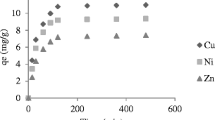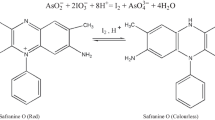Abstract
The chapter presents a study of the adsorption capacity of zinc ions from aqueous solutions in natural adsorbents (bagasse ash of red variety sugarcane, coconut shell, activated carbon, and bentonite) from Mozambique. As a heavy metal, zinc has maximum allowable concentration in the drinking water of 5 mg/L according to the Mozambican norm. The environmental pollution caused by the discharge of effluents with contents outside the dumping regulations of Mozambique can be reduced by the use of local materials. According to the results of kinetic studies, the models which better adjust were the pseudo-second order which indicate a physical-type adsorption. Bagasse ash of red variety sugarcane presented the higher adsorption capacity while coal had the lower capacity.
Access provided by Autonomous University of Puebla. Download conference paper PDF
Similar content being viewed by others
Keywords
1 Introduction
Zn (II) ion is an essential micronutrient and, in general, is considered one of the elements less dangerous. For humans, the feeding sources of zinc are mainly oysters, animal’s livers, beer yeasts, meat, and vegetables [5]. The concentration of Zinc in drinking water is low and varies from 0.01 to 1 mg/L. If there are favorable conditions, the gastrointestinal absorption is 20–30% [4]. Thus it is favored by cysteine, methionine and histidine amino acids, sugars like fructose and lactose, and vitamin C. On the contrary, it is hindered by high doses of phosphorus, copper, manganese, iron, and tin. Zinc accumulates in the liver, pancreas, kidneys, and prostate [2].
The presence of zinc in a wide variety of enzymes demonstrates its important role in metabolism. The Food and Nutrition Board of the National Academy of Sciences recommends a daily intake of 15 mg of this element for adults. Its lack causes growth decline, marked hypogonadism, and rough and dry skin [2].
Despite being an essential element, at high dosages can be toxic for humans. Among others, toxicity symptoms include vomiting, dehydration, electrolyte imbalance, abdominal pain, lethargy, dizziness, and loss of muscle coordination. Daily doses of 150 mg interfere with the metabolism of copper and iron [2]. The chapter presents possibility to the lower concentrations of this ion in water, by removing it using bagasse ash of Mozambique red variety sugarcane as adsorbent.
Problem: Environmental pollution caused by the discharge of effluents with contents outside the dumping regulations of Mozambique.
General objective: Characterize and use the bagasse ash of red variety sugarcane, coconut shell, chemically activated carbon, and bentonite of Mozambique as sorbent for zinc removal in model solutions.
2 Materials and Methods
The bagasse ash used was obtained under preset thermal conditions, and the Mozambican coconut shell carbon was obtained by treatment with phosphoric acid 0.6 mol/L and bentonite of Boane region. These materials are characterized from the physical point of view by the determination of pycnometric densities, apparent, apparent by imprisonment, tortuosity, compressibility, and porosity. The determination of the specific surface is possible. In the case of activated carbon, it is necessary to set a series of characteristic parameters for this type of material.
The kinetic of sorption process is evaluated by absorption atomic method. In this study, silicate is brought into contact with known concentration of zinc (II) nitrate solution, for a certain time, to obtain the concentration values of Zn (II) ions at time intervals.
The results obtained from this method are evaluated with the following different kinetic models [1, 3]:
-
Pseudo-first order (PFO),
-
Pseudo-second order (PSO),
-
Elovich model (EM),
-
Intraparticle diffusion (DIP).
Related equations are presented below:
Pseudo-first-order model
Pseudo-second order
Elovich model
Intraparticle diffusion model
where
- q e :
-
quantity of sorbed metal at equilibrium (mg/g)
- q t :
-
quantity of sorbed metal at any time (mg/g)
- t :
-
time (min)
- k 1 :
-
pseudo-first-order velocity constant (min−1)
- k 2 :
-
pseudo-second-order velocity constant (g/mg min)
- k d :
-
intraparticle diffusion velocity constant (mg/g s1/2)
- α :
-
initial sorption velocity (mg/g min)
- β :
-
desorption constant (g/mg)
- C e :
-
concentration of solute at equilibrium (mg/L)
- C o :
-
solute initial concentration (mg/L)
- a :
-
constant related to thermal adsorption
- k ads :
-
first- and second-order adsorption velocity constant
- m :
-
sorbent mass
- V :
-
volume of the solution.
3 Analysis of Results
-
Bagasse ash of sugarcane characterization
The bagasse ash of sugarcane used, obtained, has a series of characteristics that are exposed in Table 1.
Table 1 Sugarcane bagasse ash physic parameters -
Characterization of the coconut shell powder
The results obtained in the coconut shell powder characterization tests are summarized in Table 2.
Table 2 Coconut shell powder physic parameters -
Characterization of coal obtained from coconut shell
Coal obtained from coconut shell has characteristics presented in Table 3.
Table 3 Coconut coal physical parameters -
Characterization of bentonite
Below in Table 4 are the results of the bentonite used.
Table 4 Physic parameters of the bentonite used -
Kinetic studies
The results of the kinetic study are shown below in Table 5.
Table 5 Bilinear correlation coefficients for each adsorbent
In general terms, the pseudo-second-order model is adjusted to the four adsorbents. However, the Elovich model for bentonite predicts the overlap of a chemical interaction between adsorbate and adsorbent. The adjustment of the diffusional model for bentonite is noteworthy given the high value of the bilinear correlation coefficient obtained.
Below in Table 6 are the values obtained from the parameters corresponding to pseudo-second-order model.
It is worth mentioning the diffusional model in bentonite, where the diffusivity of the zinc (II) ion is 7.52 × 10−14 m2/s, value within the order for ions that do not have an accentuated polarizability.
4 Conclusions
-
1.
The kinetic model of pseudo-second order is adjusted to the adsorption of the zinc (II) ion in the adsorbents sugarcane bagasse ash, coconut shell powder, chemically activated coconut coal, and bentonite from the Boane region in Mozambique, which advocates a physical-type adsorption.
-
2.
The maximum adsorption capacity of the zinc (II) ions, the maximum initial velocity, and the shortest half-life are represented by the bagasse ash of sugarcane variety Roxa, while coal is the worst of the adsorbents used.
References
Chun-I L, Li-Hua W (2008) Rate equations and isotherms for two adsorption models. J Chin Inst Chem Eng 39(6):579–585
Dangcong P, Bernet N, Degedenes JP, Moletta R (2000) Effects of oxygen supply methods on the performance of a sequencing batch reactor for high ammonium nitrification. Water Environ Res 72(2):195–200
Igwe JC (2006) A bioseparation process for removing heavy metals from waste using biosorbents. Afr J Biotechnol 5(12):1167–1179
Metal Environmental Health Criteria 54 (1986) World Health Organization, Geneva, pp 11–15
US Environmental Protection Agency (1999) Update of ambient water quality criteria for Zn (II), EPA’822/R-99-014
Author information
Authors and Affiliations
Corresponding author
Editor information
Editors and Affiliations
Rights and permissions
Copyright information
© 2019 Springer Nature Switzerland AG
About this paper
Cite this paper
Prieto-García, J.O., Suarez, E.R., Gulamussen, N.J., Trujillo, Á.M. (2019). Mozambican Adsorbents for Zinc (II) Removal in Aqueous Solutions. In: Cárdenas, R., Mochalov, V., Parra, O., Martin, O. (eds) Proceedings of the 2nd International Conference on BioGeoSciences. BG 2017. Springer, Cham. https://doi.org/10.1007/978-3-030-04233-2_12
Download citation
DOI: https://doi.org/10.1007/978-3-030-04233-2_12
Published:
Publisher Name: Springer, Cham
Print ISBN: 978-3-030-04232-5
Online ISBN: 978-3-030-04233-2
eBook Packages: Earth and Environmental ScienceEarth and Environmental Science (R0)




